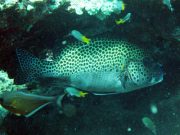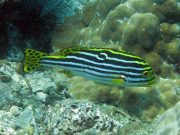Dykning med Sødlæber
Koh Lantas Marineliv | Plectorhynchinae
Sødlæber er let genkendelige på deres lille mund, store, fyldige læber og karakteristiske farvemønstre, og ses ofte under dykkerture på Koh Lanta. Deres farver og mønstre er meget varierede, lige fra ensfarvede til plettede, plettede, båndede og stribede.
Disse bundlevende grunts er normalt ensomme eller lever i små grupper eller par. De er komprimerede fisk med et stærkt udadbuet hovedprofil og en rille i hagen. Sødlæber gennemgår en række dramatiske farve- og mønsterændringer i løbet af deres liv, hvor ungfiskene ser helt anderledes ud end de voksne.
Sødlæber kan ofte ses i små grupper under overhæng, afsatser eller andre skjulesteder og kan lejlighedsvis omgås andre sødlæber. Disse fisk er bundlevende rovdyr, og om natten søger de efter bundlevende hvirvelløse byttedyr, såsom børsteorm, rejer og små krabber.
3 arter fundet på denne side:
Gold-spotted Sweetlips
(Plectorhinchus flavomaculatus)

Plectorhinchus flavomaculatus @ Hin Bida
The Gold-Spotted Sweetlips has a generally light grey coloured body, with yellowish-gold stripes and spots on the head and small yellowish-gold spots on the upper body, extending onto the dorsal and tail fins. Spots on the fins are often darker. There is a dusky lower margin on the tail fin.
The Gold-Spotted Sweetlips grows to 60 cm, but more usually observed 25 cm - 30 cm. This species is observed solitary, or in small groups and the diet includes small fish and crustaceans.
Harlequin Sweetlips
(Plectorhinchus chaetodonoides)
The Harlequin Sweetlips exhibits wildly contrasting colouring at various stages of its life, with the adult coloration and pattern being very different to the juvenile colouration.
The adult Harlequin Sweetlips has a whitish to yellowish or greenish body, with many small dark brown spots on the head, body and fins. The belly is whitish - greyish, and without spots.

Adult Plectorhinchus chaetodonoides @ Koh Bida
Sub-adult Harlequin Sweetlips are in the transition stage from juvenile to adult and have a whitish body occasionally with yellowish or greenish tinting on the back. The darker body patterns are reminiscent of the juvenile patterns, but starting to fade. The body and tail fin are covered in many small brown spots.
Juvenile Harlequin Sweetlips have a brown body and several large creamy-white, dark-edged blotches. The fins have white margins. Juveniles swim face-down, with a strange undulating, or wave-like wiggle, moving their fins in opposing circular movements. This strange dance is designed to look like a poisonous flatworm or nudibranch in order to deter predators.
Adults can reach 72 cm, but more often observed in the 30 cm range. This species is nocturnal, usually solitary and can be found near ledges on the reef edge. The diet includes crustaceans, molluscs, and fish.
Oriental Sweetlips
(Plectorhinchus vittatus)

Plectorhinchus vittatus @ Koh Bida
The Oriental Sweetlips has a pale grey to white body with black stripes and a yellow face. The black stripes are usually wider on the upper part of the body. All of the fins are yellow, with the dorsal, anal and tail fins having black blotches and spots.
The Oriental Sweetlips can grow to 85 cm, but more usually observed around 25 cm - 30 cm. This is a nocturnal feeder, whose diet includes other smaller fish. Usually encountered solitary, but may form small groups.
Dykning med Sødlæber omkring Koh Lanta
Dykning og snorkelture
Hvis du gerne vil have chancen for at se Sødlæber på en af vores daglige dykkerture i højsæsonen fra Koh Lanta, så send os en e-mail til info@diveandrelax.com.
Deltag i vores speedbådsdykkerture i højsæsonen til nogle af Thailands bedste dykkersteder og nyd små grupper, korte rejsetider med fokus på god personlig service, sikkerhed og sjov.
Er du endnu ikke certificeret dykker? Lær at dykke på Koh Lanta med det 3-dages SSI Open Water Diver-kursus.
Book online og spar 10% på dykkerture og dykkerkurser på Koh Lanta.
Få mere at vide
Indo-Stillehavets havdyrsguider
- Allen, G., Steene, R., Humann, P., DeLoach, N. (2003) Reef Fish Identification, Tropical Pacific. Jacksonville, FL., USA: New World Publications, Inc., ISBN 1-878348-36-1.
- Humann, P., DeLoach, N., (2010) Reef Creature Identification, Tropical Pacific. Jacksonville, FL., USA: New World Publications Inc., ISBN 978-1-878348-44-9
- Debelius, H. (2013) Indian Ocean Reef Guide. Frankfurt, Germany: IKAN - Unterwasserarchiv, ISBN 978-3-939767-52-7.
- Debelius, H. (2004) Nudibranchs and Sea Snails, Indo-Pacific Field Guide. Frankfurt, Germany: IKAN - Unterwasserarchiv, ISBN 3-925919-51-1
- Erhardt, H., Knop, D. (2015) Corals Indo-Pacific Field Guide. Frankfurt, Germany: IKAN - Unterwasserarchiv, ISBN 3-925919-69-4.
- Veron J.E.N., Stafford-Smith M.G., Turak E. and DeVantier L.M. (2016). Corals of the World
Flere referencer om havets dyreliv og yderligere information


